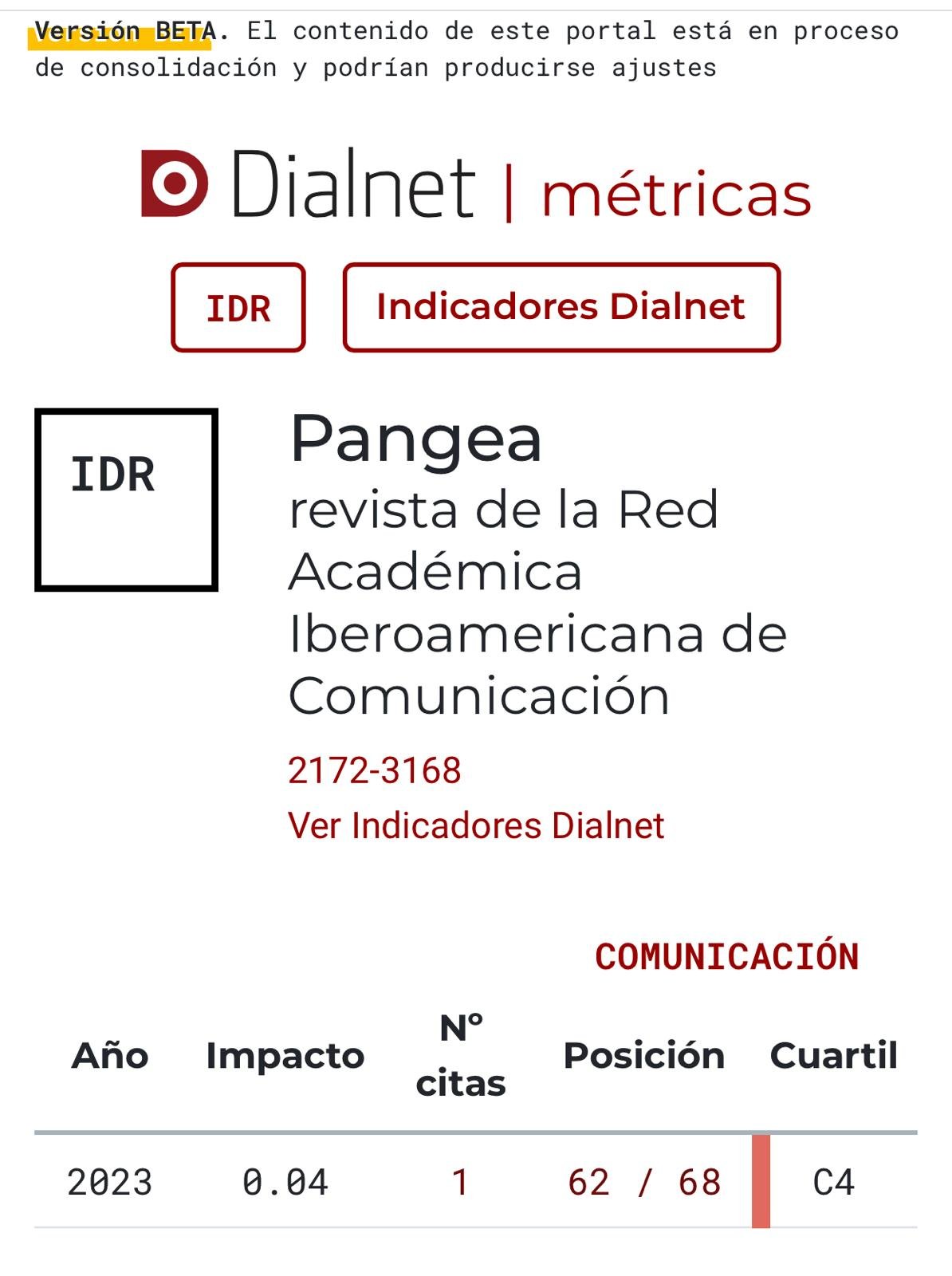Satisfacción del consumidor y comunicación interpersonal en restaurantes de España, Francia, México y Portugal
DOI:
https://doi.org/10.52203/pangea.v12i1.137Palabras clave:
interacciones de servico, comunicación verbal, comunicación no verbal, comunicación intercultural, satisfacción del consumidor, empleados de primera líneaResumen
La satisfacción de los consumidores en los restaurantes es uno de los tópicos que más atención ha recibido por parte de los investigadores identificándose como principal variable independiente a la calidad del servicio, no obstante, es poca la literatura en Iberoamérica que estudie a la comunicación interpersonal como mediadora de los procesos de interacción consumidor-mesero en los restaurantes orientados a lograr la satisfacción del consumidor. Este estudio exploratorio tuvo como finalidad comprender cómo la comunicación en las interacciones entre empleado–consumidor influye en la satisfacción del consumidor en restaurantes. Se realizaron entrevistas a profundidad a gerentes, empleados de servicio y consumidores de restaurantes de España, Francia, México y Portugal. Los resultados evidencian la importancia de que los empleados se comuniquen verbalmente de forma moderada y natural, que sean ágiles al momento de atender al comensal sin descuidar la calidad de la interacción y que hagan uso de la comunicación para propiciar una experiencia gastronómica satisfactoria. En los restaurantes de Europa la capacitación es clave para que los empleados generen confianza al consumidor mientras que en México los empleados se apoyan de la comunicación verbal y no verbal principalmente para ganar confianza en el proceso de atención al consumidor.
Referencias
Almohaimmeed, B. (2017). Restaurant Quality and Customer Satisfaction. International Review of Management and Marketing, 7(3), 42-49. https://www.econjournals.com/index.php/irmm/article/view/4452
Babin, E. (2013). An examination of predictors of nonverbal and verbal communication of pleasure during sex and sexual satisfaction. Journal of Social and Personal Relationships, 30(3), 270-292.
Baker, D. y Crompton, J. (2000). Quality, Satisfaction and Behavioral Intentions. Annals of Tourism Research, 27, 758-804. doi:10.1016/S0160-7383(99)00108-5.
Berry, L., Carbone, L. y Haeckel, S. H. (2002). Managing the total customer experience. MIT Sloan management, 43, 85-89. https://www.researchgate.net/publication/266277275_Managing_the_Total_Customer_Experience_Managing_the_Total_Customer_Experience
Birdwhistell, R. (1952). Introduction to kinesics: An annotation system for analysis of body motion and gesture. Louisville, KY: University of Louisville.
Bojanic, D. y Rosen, D. (1994). MEASURING SERVICE QUALITY IN RESTAURANTS: AN APPLICATION OF THE SERVQUAL INSTRUMENT. Hospitality Reserch Journal, 3-14. https://doi.org/10.1177/109634809401800102
Botía Sanabria, M. L., & Orozco Pulido, L. H. (2012). Competencias en servicio al consumidor y efectividad en solución de problemas. Sus características en el sector turismo. Estudios y Perspectivas en Turismo, 21(3),646-662 https://www.redalyc.org/articulo.oa?id=180724044006
Brzozowska-Woś, M. y Schivinski, B. (2019). The Effect of Online Reviews on Consumer-Based Brand Equity: Case-Study of the Polish Restaurant Sector. Central European Management Journal, 2-27. 10.7206/cemj.2658-0845.1
Bujisic, M. y Hutchinson, J. (2014). The effects of restaurant quality. International Journal of Contemporary Hospitality Management, 26(8), 1270-1291. https://doi.org/10.1108/IJCHM-04-2013-0162
Chan, M. y Chandra-Sagaran, U. (2019). Scripted communication for service standardisation? What analysis of conversation can tell us about the fast-food service encounter. Discourse & Communication, 13(1), 3-25. doi:10.1177/1750481318801625
Chaudhry, S. J. y Loewenstein, G. (2019). Thanking, apologizing, bragging, and blaming: Responsibility exchange theory and the currency of communication. Psychological Review, 126(3), 313-344. doi:10.1037/rev0000139
Cronin, J., Brady, M. K. y Hult, G. T. (2000). Assessing the Effects of Quality, Value, and Customer Satisfaction on Behavioral Intention in Service Environments. Journal of Retailing, 76, 193-218. https://doi.org/10.1016/S0022-4359(00)00028-2
Diab, D., Mohammed, H., Mansour, E. y Saad, O. (2016). Investigating the impact of key dimensions of service quality on customers’ satisfaction and loyalty: Evidences from the restaurant industry in Sudan. Marketing and Branding Research 3 153-165. 10.33844/mbr.2016.60459
DiPietro, R. (2017). Restaurant and foodservice research: A critical reflection behind and an optimistic look ahead. International Journal of Contemporary Hospitality Management, 29(4), 1203-1234. https://doi.org/10.1108/IJCHM-01-2016-0046
Erkmen, E. y Hancer, M. (2015). Do your internal branding efforts measure up? Consumers’ response to brand supporting behaviors of hospitality employees. International Journal of Contemporary Hospitality Management , 27(5), 878-895. https://doi.org/10.1108/IJCHM-10-2013-0442
Fearon, D. (2004). Georg Simmel, The Sociology of Space. CSISS Classics. https://escholarship.org/uc/item/7s73860q
Gabbott, M. y Hogg, G. (2000). An empirical investigation of the impact of non-verbal communication on service evaluation. European Journal of Marketing, 34, 384-398. https://doi.org/10.1108/03090560010311911
Garbarino, E. y Johnson, M. (1999). The Different Roles of Satisfaction, Trust and Commitment in Customer Relationships. Journal of Marketing, 3(2), 70-87. https://doi.org/10.2307/1251946
García Rodríguez, N., Álvarez Álvarez, B. y Santos Vijande, M. L. (2011). Aplicación de la Lógica Dominante del servicio (LDS) en el sector turístico: el marketing interno como antecedente de la cultura de co-creación de innovaciones de innovaciones con consumidores y empleados. Cuadernos de Gestión, 11(2), 53-75. https://www.redalyc.org/articulo.oa?id=274320119003
García, A. (2016). Cultura de servicio en la optimización del servicio al consumidor. TELOS 18(3), 381-398. https://www.redalyc.org/articulo.oa?id=99346931003
Goffman, E. (1956). The Presentation of Self in Everyday Life. University of Edinburgh Press.
Goffman, E. (1959). The Presentation of Self in Everyday Life. Doubleday.
Arris, E., Brown, T., Mowen, J. y Artis, A. (2014). Exploring the Role of Productivity Propensity in Frontline Employee Performance: Its Relationship with Customer Orientation and Important Outcomes. Psychology and Marketing, 3(13), 171-183. Doi: 10.1002/mar.20685
Ivkov, M., Božić, S. y Blešić, I. (2019). The effect of service staff’s verbalized hospitality towards group diner’s additional purchases and tipping behaviour. Scandinavian Journal of Hospitality and Tourism, 19(1), 82-94. doi:10.1080/15022250.2017.1415
Jacob, C., Guéguen, N., & Boulbry, G. (2014). Using verbal attention to enhance restaurant customer satisfaction and behavior. International Journal of Hospitality Management, 39, 50-52. doi:10.1016/j.ijhm.2014.02.004
Jana, A. (2014). Impacts of the attributes of servIce qualIty on customer satisfaction and the interrelationship among service quality, customer satisfaction and customer loyalty: a study of casual dinning restaurant of Ranchi. Journal of Hospitality Application & Research, 9(2), 46-61. http://www.publishingindia.com/johar/7/impacts-of-the-attributes-of-service-quality-on-customer-satisfaction-and-the-interrelationship-among-service-quality-customer-satisfaction-and-customer-loyalty/352/2600/
John, D. y Whitney, J. (1986). The Development of Consumer Knowledge in Children: A Cognitive Structure Approach. Journal of Consumer Research, 4, 406-417. doi:10.1086/208526.
Jones, D., McCleary, K. y Lepisto, L. (2020). CONSUMER COMPLAINT BEHAVIOR MANIFESTATIONS FOR TABLE SERVICE RESTAURANTS: IDENTIFYING SOCIODEMOGRAPHIC CHARACTERISTICS, PERSONALITY, AND BEHAVIORAL FACTORS. Journal of Hospitality & Tourism Research, 105-123. 10.1177/1096348002026002002
Kivelä, J. J. y Chu, C. Y. (2020). DELIVERING QUALITY SERVICE: DIAGNOSING FAVORABLE AND UNFAVORABLE SERVICE ENCOUNTERS IN RESTAURANTS. Journal of Hospitality & Tourism Research, 251-271. 10.1177/109634800102500302
Koren, M. y Pető, R. (2020). Business disruptions from social distancing. PLoS ONE, 15(9 September). doi:10.1371/journal.pone.0239113
Kostopoulos, I. (2018). Do Empowered Front-Line Employees Perform Better? A Non-linear Approach and the Role of Service Complexity? European Management Review, 16(2), 1-14. https://doi.org/10.1111/emre.12153
Lee, H. E. (2015). Does a server's attentiveness matter? understanding intercultural service encounters in restaurants. International Journal of Hospitality Management, 50, 134-144. doi:10.1016/j.ijhm.2015.08.003
Leszczynski, G. y Zielinski, M. (2013). The impact of misaligned business communication on the quality of salesperson - buyer relationships. The Poznan University of Economics Review, 13(2), 107-136. https://www.ebr.edu.pl/pub/2013_2_107.pdf
Lim, E., Lee, Y. y Foo, M. (2017). Frontline employees’ nonverbal cues in service encounters: a double-edged sword. J. of the Acad. Mark. Sci., 45, 657-676. https://doi.org/10.1007/s11747-016-0479-4
Lin, C. y Lin, J. (2017). The influence of service employees’ nonverbal communication on customer-employee rapport in the service encounter. Journal of Service Management, 28(1), 107-132. doi:10.1108/JOSM-08-2015-0251
Maldonado, J. (1997). Sociología del espacio: el orden espacial de las relaciones sociales. Política y sociedad, 25, 21-36. https://revistas.ucm.es/index.php/POSO/article/view/POSO9797230021A
Marzo, J. C., Martínez Tur, V., Ramos, J. y Peiró, J. M. (2002). La satisfacción del usuario desde el modelo de la confirmación de expectativas: respuesta a algunos interrogantes. Psicothema, 14(4), 765-770. https://www.redalyc.org/articulo.oa?id=72714412
Matsumoto, D. (2006). Are cultural differences in emotion regulation mediated by personality traits? Journal of Cross-Cultural Psychology, 37(4), 421-437. https://davidmatsumoto.com/content/2006%20Matsumoto%20JCCP.pdf
McDuffie, A. (2021). Verbal Communication. In Encyclopedia of Autism Spectrum Disorders. https://doi.org/10.1007/978-3-319-91280-6_1709
Montesinos, O., Froufe, M. y Sierra, B. (2014). La experiencia emocional ante fallos y acciones correctoras en la prestación de servicio. Una aproximación desde la teoría del Script. In A. M. Acosta y L. J., Avances en el estudio de la motivación y la emoción (pp. 71-76). Granada.
Nathanson, D. (1992). Shame and Pride: Affect, Sex, and the Birth of the Self. W. W. Norton and Co.
Ogletree, Y. (2014). The relationship between service quality and customer loyalty in the quick service restaurant industry [Tesis de Doctora no publicada] Argosy University.
Padilla Cruz, M. y Martínez López, N. (2017). Interlanguage pragmatics in a service encounter: diagnosing how Spanish learners of English for the Tourism Industry inform tourists at a visitor centre. Letras De Hoje, 52(3), 310-321. https://doi.org/10.15448/1984-772
Parasuraman, P. A., Zeithaml, V. y Berry, L. (1985). A Conceptual Model of Service Quality and Its Implications for Future Research. Journal of Marketing, 49(4), 41-50. https://doi.org/10.2307/1251430
Sabido, O. (2007). El sentir de los sentidos y la sociología de las emociones en la obra de Georg Simmel. In G. Simmel, Una revisión contemporánea (pp. 211-230). Anthropos / UamAzcapotzalco.
Sabido, O. (2016). Capítulo 9 Alcances teórico-metodológicos de la sociología relacional de Georg Simmel. In E. Vernik y H. Borisonik, Georg Simmel, un siglo después: actualidad y perspectiva (pp. 133-149). Universidad de Buenos Aires.
Samovar, L., Porter, R. E. y Mc Daniel, E. (2009). Communication Between Cultures, seventh ed. Thomson Wadsworth.
Sánchez-Hernández, R. M., Martínez-Tur, V., González-Morales, M. G., Ramos, J., & Peiró, J. M. (2009). Un análisis transnivel de las relaciones de la calidad de servicio y la confirmación de expectativas con la satisfacción de los usuarios. Psichotema 21(3), 421-426. from https://www.redalyc.org/articulo.oa?id=72711821013
Sean, S. (2010). Predictors of Relationship Quality and Loyalty in the Chain Restaurant Industry. Cornell Hospitality Quarterly, 51(2), 251-267. https://doi.org/10.1177/1938965510363264
Shiu, Y. y Yu, T. (2010). Internal marketing, organisational culture, job satisfaction, and organisational performance in non-life insurance. The Service Industries Journal, 30(60), 793-809. https://doi.org/10.1080/02642060701849840
Simmel, G. (1986). Sociología de la comida. In El individuo y la libertad. Ensayos de crítica de la cultura (pp. 253-270). Península.
Simmel, G. (2003). Estudios psicológicos y etnológicos sobre música. Gorla.
Simmel, G. (2014). Digresión sobre la sociología de los sentidos. In S. e. socialización, (2014 a). Digresión sobre la sociología de los sentidos. En Sociología: estudios sobre las formas de socialización. Trad. José Pérez Bances. México: Fondo de Cultura Económica, pp 622- 637.
Spencer-Oatey, E. (1992). Cross-cultural politeness: British and Chinese conceptions of the tutor-student relationship [Tesis Doctoral no publicada] Lancaster University.
Stevens, P., Knutson, B. y Patton, M. (1995). Dineserv: A Tool for Measuring Service Quality in Restaurants. Cornell Hotel and Restaurant Administration Quarterly, 36(2), 56-60. https://doi.org/10.1177/001088049503600226
Storbacka, K., Strandvik, T. y Gronroos, C. (1994). Managing customer relationships for profit: The dynamics of relationship quality. International Journal of Service Industry Management, 5(5), 21-38.
Surprenant, C. y Solomon, M. (1987). Predictability and Personalization in the Service Encounter. Journal of Marketing, 51, 86-96. doi:10.1177/002224298705100207.
Tomkins, S. S. (1978). Script Theory: Differential magnification of affects. University of Nebraska Press.
Tomkins, S. S. (1992). Affect Imagery Consciousness (Vol. 4). Springer.
Tomkins, S. S. (1995). Exploring Affect, ed. E. Virginia Demos. Cambridge University Press.
Vázquez-Carrasco, R. y Foxall, G. (2006). Influence of personality traits on satisfaction, perception of relational benefits, and loyalty in a personal service context. Journal of Retailing and Consumer Services, 13(3), 205-219. doi:10.1016/j.jretconser.2005.08.006
Vera M., J. y Trujillo L., A. (2009). El Papel de la Calidad del Servicio del Restaurante como Antecedente de la Lealtad del Consumidor. Panorama Socioeconómico, 27(38), 16-30. https://www.redalyc.org/pdf/399/39912023003.pdf
Woods, R. H. (1991). When servers meet customers: an analysis of the role of restaurant servers. Hospitality Research Journal, 539-559. https://doi.org/10.1177/109634809001400257
Wu, H.-C. y Mohi, Z. (2015). Assessment of Service Quality in the Fast-Food Restaurant. Journal of Foodservice Business Research, 18(4), 358-388. doi: 10.1080/15378020.2015.1068673
Yang, F. X. (2013). Effects of Restaurant Satisfactiona and Knowledge Sharing Motivation on EWOM Intentions: The Moderating Role of Technology Acceptance Factors. Journal of Hospitality & Tourism Research, 1-35. 10.1177/1096348013515918
Descargas
Publicado
Número
Sección
Licencia
Derechos de autor 2021 María Dolores Lozano Gutiérrez, Ricardo Ignacio Prado Hurtado

Esta obra está bajo una licencia internacional Creative Commons Atribución-NoComercial-SinDerivadas 4.0.
https://creativecommons.org/licenses/by-nc-nd/4.0/deed.es





